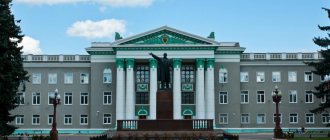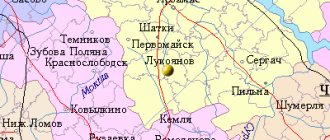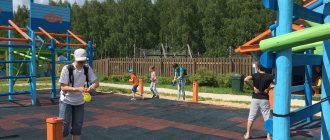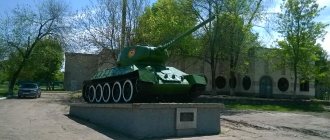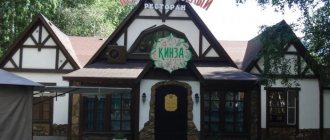The Bryansk region was formed by the Decree of the Presidium of the Supreme Soviet of the USSR on July 5, 1944. It included 26 western districts of the Oryol region. The territory of the region extends from west to east for 270 kilometers, and from north to south for 190 kilometers. The coordinates of its extreme northern and southern points are 54° 05′ and 52° 10′ north latitude, the extreme western and eastern points are 31° 10′ - 35° 20′ east longitude.
Of all the central regions of the Russian Federation, the Bryansk region extends most deeply to the west into the borders of two neighboring fraternal republics: Ukraine and Belarus.
Attractions
- Svensky Monastery is one of the most ancient monasteries in Russia. According to legend, it was founded in 1288 by the Bryansk prince Roman Mikhailovich. The monastery is located in the village of Suponevo, near the confluence of the two rivers Desna and Sveni.
- The Bryansk Forest Nature Reserve was created in the Bryansk region in 1987. Located on the territory of the Trubchevsky and Suzemsky districts, between the Desna River and the Nerussa River. The symbol of the reserve is the black stork. This rare bird is listed in the Red Book and is protected not only in Russia, but also in a number of other countries.
- The museum-estate of A.K. Tolstoy in the village of Krasny Rog is one of the most popular attractions in the Bryansk region. The estate was built in the mid-eighteenth century and belonged to Count Razumovsky, and then passed on to the Tolstoy family.
- The Khatsun memorial complex is based on the site of the village of the same name, where in 1941 the Nazis killed all civilians. The memorial is dedicated to the memory of villages and villages destroyed by the Nazis during the Great Patriotic War.
Tourism in the Central Federal District
You can read more about tourism and the attractions of the Central Federal District in the descriptions of the regions. The district is very attractive for tourists; there are both natural and architectural attractions. Moscow alone attracts millions of tourists every year, but there is also the Golden Ring of Russia and hundreds of other interesting places.
From a tourism point of view, the Central Federal District stands out from almost all other districts due to its developed transport infrastructure. Almost any part of the district can be reached without problems, and there is no need to talk about popular and famous places.
Bridge across three states
The Bryansk region is known for its unique geographical and geopolitical position. It borders on two states at once - Ukraine and Belarus. This circumstance, coupled with the creative activities of the Bryansk leadership, is the most important tool for implementing the country’s foreign policy concept. The governor of the Bryansk region told a Rossiyskaya Gazeta correspondent about how it is being implemented in the Bryansk region.
We are partners
Nikolay Denin:
There are many threads connecting the Bryansk region with Ukraine and Belarus. The strongest of them is the thread of economic cooperation. But this cooperation cannot be defined only by the framework of business relationships. It is much deeper, which is facilitated by the centuries-old kinship of the three Slavic peoples. We have the same historical, geographical and ethnic roots.
In recent years, the Bryansk region has entered into a regime of sustainable dynamic development. In terms of such a key indicator as growth in industrial production, it is one of the leading Russian regions. This might not have happened if the region had not expanded and deepened trade and economic ties.
Russian newspaper:
Nikolai Vasilyevich, a number of projects and programs are being implemented in the Bryansk region, the goal of which is to improve people’s living standards. What is the role of international cooperation with foreign partners in this?
Denin:
The increasing role of cooperative ties with neighboring states. In this regard, our relations with the Gomel and Chernigov regions of the Republic of Belarus and Ukraine are indicative. They are characterized as the most stable and with real prospects.
Today, about five hundred enterprises with foreign investment operate in the Bryansk region. A significant part of them are represented by Belarusian investors. We are bound by 12 intergovernmental and regional cooperation agreements. Moreover, direct interaction, in my opinion, is the most effective.
RG:
What does the Bryansk region get from such cooperation?
Denin:
The results of cooperation are visibly expressed in numbers. Last year, the volume of foreign trade with the Republic of Belarus exceeded $200 million. 182 enterprises supplied the Belarusian market. There are 22 enterprises operating under the banner “Belarusian Goods” in the Bryansk region. Exports of wood products, spare parts for railway transport, bicycles, food products and raw materials for their production, petrochemical products and mechanical engineering are growing. Imports of Belarusian goods have also increased significantly - dairy and meat products, confectionery, paper and cardboard, machinery and equipment.
Klintsy enterprises actively cooperate with the Republic of Belarus - a piston ring plant, a truck crane plant, and a twine factory.
Novozybkovsky supplies high-frequency generators to Minsk. With the participation of Belarusian investors, a joint Russian-Belarusian enterprise for the production of soft toys began operating in Klintsy. Bryansk Ivot Steklo supplies basalt materials for gas stoves to Brest, Mogilev and Gomel.
There are many such examples. More than three and a half thousand tractors made in Belarus work in the fields of the Bryansk region.
RG:
One of the powerful incentives for the development of bilateral Russian-Belarusian cooperation is industrial cooperation in the form of creating joint ventures in various industries. How is this tool for strengthening integration ties used today in the Bryansk region?
Denin:
The consequence of our business relationship with the Gomel region was the implementation of an investment project related to the creation of a joint Russian-Belarusian enterprise CJSC JV Bryanskselmash. It specializes in the production of grain harvesting and forage harvesting equipment. One of the founders of the enterprise was the Belarusian Gomselmash. Constantly increasing production output, the company has made a real breakthrough. At the Russian Field exhibition, combines produced in Bryansk were awarded gold medals, and one of them even received the Grand Prix.
In September, a visiting meeting of the State Duma Committee on CIS Affairs and Relations with Compatriots was held in Bryansk, where they discussed the practice of cooperation between the Bryansk region and the border regions of Belarus and Ukraine. And before the meeting, our guests - State Duma deputies, representatives of Russian ministries and departments, authorities of several Russian regions, as well as our neighbors - Sumy, Chernigov and Gomel residents - visited Bryanskselmash.
RG:
Today, due to the foreign policy course of the Ukrainian president, many are talking about a cooling in relations between Russia and Ukraine. If this is so, then how does the Bryansk region, which is connected with Ukraine by many ties, survive this period?
Denin:
No, not at all. The indicators of foreign trade turnover of the Bryansk region and Ukraine are even more significant. Last year it exceeded $630 million. Mutually beneficial agreements connect the Bryansk region with the Zhitomir, Chernigov, and Sumy regions. The fruits of this cooperation are clearly visible at numerous joint exhibitions and product presentations in which foreign enterprises participate.
Recently, together with our Sumy colleagues, we solved a long-standing border problem. I'm talking about the section of the state border in the area of the Russian station Zernovo and the Ukrainian town of Seredina-Buda. The absence of a vehicle checkpoint in this area created a lot of inconvenience for residents of border areas. But they lived here together for a long time, and the border separated close people - elderly parents and adult children, aunts and nephews, friends and godmothers. In order not to waste time on a long detour, many of them decided to, so to speak, illegally cross the border.
There is an agreement between our countries that provides for the procedure for border crossing by residents of border areas. But in reality, its conditions were not met due to the lack of arrangement of crossing points. Now this issue has been resolved, and even a local bus will run across the border.
Special position and special tasks
RG:
This summer marks five years since the creation of the Bryansk, Gomel and Chernigov regions of the Dnepr Euroregion. It was planned that it would contribute to the development of cross-border contacts and the implementation of joint projects in various industries. Is it possible to talk about fulfilling these tasks?
Denin:
Euroregion "Dnepr" received observer status in the Association of European Border Regions (AEBR), and now the issue of granting the community the status of a full member is being considered. Within the community, specific tripartite projects in the fields of economics, environmental protection, education and the socio-cultural sphere are being successfully implemented.
It should be noted that there is active interaction within the Euroregion of chambers of commerce and industry. Exhibitions, fairs and investment forums contribute to the growth of mutual investments, expansion of the range of supplied goods, and the creation of joint ventures. At the end of summer, we held the traditional Svensk Fair in Bryansk, and the products of the community enterprise, as always, were in demand. In general, exhibitions and fairs are an amazing thing. In a few days it is possible to achieve such progress that only recently one could only dream of.
RG:
How would you comment on the results of cooperation between the regions of the Euroregion in the field of environmental management?
Denin:
As they say, only rains fall on our fields and only rivers flow through our lands. So we are simply doomed to preserve all this together. Moreover, we already have extensive joint experience in overcoming the Chernobyl disaster. To prevent and eliminate the consequences of emergency situations of a man-made or natural nature in border areas, the Department of the Ministry of Emergency Situations of Russia in the Bryansk Region and the Gomel Regional Department of the Ministry of Emergency Situations of the Republic of Belarus have agreed on a set of measures for interaction. This year, the Chernihiv region is joining this work.
The three regions agreed to actively cooperate in the prevention of transboundary pollution of water bodies and the protection of flora and fauna. In particular, the analytical laboratory of the Gomel Regional Committee for Natural Resources and Environmental Protection, together with the Bryansk branch of the Center for Laboratory Analysis and Technical Measurements, is conducting a joint study of the Iput River.
RG:
How is international cooperation developing in the field of humanitarian ties?
Denin:
Interaction and mutual understanding are very important here. It is. Bryansk State University named after I. Petrovsky actively cooperates with Belarusian partners.
Students, young scientists, and teachers at universities in neighboring countries have long become close to each other. And not only universities. There is a pedagogical college in the city of Surazh, Bryansk region. Every fourth student of this educational institution is a citizen of Belarus. It is no coincidence that the international conference “Formation of a single educational space” was held here, at which an agreement was reached on cooperation in the field of education between the Bryansk and Mogilev regions. It provides, in particular, for joint training of primary school teachers.
The international festivals “Slavic Theater Meetings”, which are held in Chernigov, Gomel and Bryansk, have long become traditional and beloved.
Representatives of Russian, Belarusian and Ukrainian media have long-standing business contacts. Joint newspaper releases, creative trips, press tours - these and other forms of cooperation enrich each of the parties. Even the “Bryansk Men”, this is our KVN team, take part in competitions of the same clubs for the prize of the Chernigov mayor. So this is real public diplomacy!
Optimism of public diplomacy
RG:
This is an interesting topic. Public diplomacy, as a way of bringing ordinary people closer together, acts together with the state in dialogue with other countries and cultures. How effective are projects in this area?
Denin:
I am convinced that it is public diplomacy that is the engine in expanding contacts and bringing peoples closer together, in forming a belt of good neighborliness along the perimeter of Russian borders and in preventing potential conflicts. I also believe that the involvement of young citizens of neighboring Slavic peoples in this activity is a good basis for future integration processes.
RG:
You are talking about the “Slavic Unity” festival...
Denin:
And about this too. “Slavic Unity” is a unique festival. The fact is that the Bryansk region is not just a border region. There is a point on her map where three borders meet at once. People call this place the junction. Once upon a time there was just a swamp. Now, from each country, three wide roads lead here, and in the center rises a mound with a monument to Friendship, which also received the popular name - “Three Sisters”. Three white ringed pylons majestically rush into the sky as a symbol of the blood unity of the Slavs.
One day a year, an ordinary miracle occurs here. About one hundred thousand people from Belarus, Russia and Ukraine come together for a common holiday. On this day, border rules cease to apply, no one asks for passports, and the currencies of three states are in use. This summer the festival was held for the 40th time.
One Ukrainian journalist who visited the festival wrote well in a Kharkov newspaper: “We don’t need to be forced to be friends. We are neighbors, and we have a common house - at least within this separate joint. And in any decent home they remember both the common roots and the difficult times when troubles were overcome by the whole world, regardless of nationality.”
At the above-mentioned meeting of the State Duma Committee on CIS Affairs, its members expressed their intention to contact the Ministry of Culture with a proposal to give the International Festival “Slavic Unity” the status of a national festival with appropriate funding from the federal budget. State Duma deputies will also petition for the inclusion of the project to create the Slavic Ring tourist route in the corresponding federal program. They expressed confidence that another of our initiatives will receive support from the executive authorities of Russia - the creation of a Russian-Belarusian university on the basis of Bryansk State University and a Russian-Belarusian college on the basis of Surazh College, every fourth student of which is a citizen of Belarus.
RG:
How did the residents of the Bryansk region perceive the tragic events in South Ossetia?
Denin:
Like all normal people - with pain and sympathy. Moreover, this sympathy had a specific material component. The collection of humanitarian aid in the region began almost immediately after the events began. It was attended by public organizations, enterprises, and ordinary residents of the region.
The Bryants delivered their cargo, which contained food, clothing, building materials, and medicines, directly to Tskhinvali. Moreover, it turned out to be very timely: the only bakery in the city ran out of flour at that moment. In the near future, another humanitarian caravan will be sent to Tskhinvali. At the same time, many Bryansk residents, including employees of the regional administration, wrote applications to transfer their one-day earnings to the fund for the victims.
What's next?
RG:
Were the factors of international cooperation taken into account when developing the Strategy for the socio-economic development of the Bryansk region for the period until 2025?
Denin:
The geographical location of the region and the associated market prospects will always be at the forefront. The Bryansk region is ready to cooperate with Ukraine, Belarus and other foreign countries in the implementation of joint projects. Joint work in various sectors of the economy, education, culture and simply public diplomacy - all this allows the Bryansk region to become a real bridge connecting Belarus, Russia and Ukraine.
Bryansk region is an ancient and young region
Located almost in the center of the Russian Plain, the Bryansk region has long been distinguished by its advantageous position and played an important role in the protection of Russian lands and the Russian state.
The region's position on the watershed of two large river systems - the Dnieper and Volga - had a great influence on its settlement and economic development. The Dnieper, where the Desna carries its waters, has long been the main artery of the western part of the Russian Plain, connecting the Bryansk region with the Volga, Don, Western Dvina, and through them with the Caspian, Azov, Black and Baltic seas. The waterway “from the Varangians to the Greeks” drew the region into a wide range of trade relations.
Administratively, the Bryansk region is relatively young. It was formed on July 5, 1944 from the western regions of the Oryol region.
The Bryansk region lies in the western part of the Russian Plain, occupying the middle part of the Desna basin and the forested watershed between it and the Oka.
Located at the junction of three states and two natural zones, the region has a rich and diverse nature. Here you can find all types of forests: coniferous, mixed, broad-leaved, as well as forest-steppe and cultivated steppe.
The region borders with two states and four regions of the Russian Federation: in the west - with Belarus (Gomel and Mogilev regions, in the north - with Kaluga and Smolensk regions, in the east and southeast - with Oryol and Kursk regions, and in the south - with Ukraine ( Chernihiv and Sumy regions).
The nature of the region is rich and varied, its mineral reserves are great.
The famous Bryansk Forest is called the lungs of Central Russia.
If you look at the geographical map of the European part of Russia, the highest point of the Central Russian Plain - its crown - is located precisely in the Bryansk region.
The main river of the region, the Desna, already a thousand years ago was, firstly, the main waterway to the Kyiv Shrines, and secondly, a channel for the spread of book culture and enlightenment from the Middle East, Byzantium, Greece to the spiritual centers of northeastern Rus'.
The territory of the Bryansk region has been inhabited by Slavic tribes since ancient times. In the 9th-11th centuries, northerners lived along the Desna, and on the forested watershed of the Desna and Oka - the Vyatichi and Radimichi. The history of the region is full of countless examples of how its inhabitants have always been among the faithful defenders of the Fatherland. The selfless struggle of the Trubians with the Polovtsians in 1185 was sung in the “Tale of Igor’s Campaign” and was reflected in the granite monuments that decorate the cities of the region.
The inhabitants of the region showed boundless love for their homeland in 1240, courageously resisting the Mongol-Tatar conquerors.
The centuries-old history of our region is a reflection of the historical, cultural, and spiritual experience of Russia. A special page in the history of Russia is the Battle of Kulikovo. “The squads of individual principalities of north-eastern Rus' went to the Kulikovo field, and the united Russian people returned.” Our fellow countryman, Bryansk boyar, and later monk, Peresvet wrote a glorious page in the history of the formation of the Russian state. Residents of the Bryansk region actively participated in the defeat of the German “dog knights” at Grunwald in 1410, the Polish-Lithuanian lords at the beginning of the 17th century, and defeated the troops of Charles XII and Napoleon.
The centuries-old history of our region is a reflection of the historical, cultural, and spiritual experience of Russia.
One of the brightest and most amazing pages in the history of World War II is the partisan movement in the Bryansk region. There is not a person in our country who does not know the song “The Bryansk Forest Made a Severe Noise.” This song is the anthem of the Bryansk region.
On a vast territory behind enemy lines, the partisans liberated and held over 500 villages and hamlets with a population of about 200 thousand people.
There is a place in the Bryansk region about which they say: “When the rooster crows there, they hear it in Belarus, and in Ukraine, and in Russia. This place is at the junction of three Slavic states. A Friendship Monument was erected here, and annual youth festivals are held here. The Bryansk region has absorbed the language, folk wisdom, traditions, and customs of three Slavic peoples.
The cultural traditions of the region are deep and rich. Bryansk region is the birthplace of Fyodor Ivanovich Tyutchev, singer Anastasia Vyaltseva... Alexey Konstantinovich Tolstoy, composer Sergei Taneyev, artist Vrubel lived and worked here in different years... The creativity of folk artists and performers is unique. The products of Dyatkovo crystal makers are known throughout the entire country outside its borders.
Map of the Bryansk region with cities and villages
More detailed information about the location of settlements can be found on Yandex maps of the Bryansk region. Here you can determine the location of large regional centers, such as:
- Bryansk;
- Novozybkov;
- Trubchevsk;
- Mutilation;
- Dyatkovo;
- Klintsy.
They are connected by the largest highways, which are indicated in detail on the road map of the Bryansk region. For tourists who travel through the central part and southwest of Russia, such a map is an indispensable assistant.
The Bryansk region is crossed by 5 federal highways. Highways pass through 60 cities and towns and more than 200 railway sidings. The road routes of the Bryansk region on the map total more than 18,000 thousand km, connect regions of the region, and provide access to the borders with neighboring states.
The railway connection is also not only a connection between the region and other constituent entities of Russia, but also an outlet abroad. The railway map of the Bryansk region roads is presented in detail and gives a clear idea of the number of stations and directions. Railways stretch over a distance of more than 1,100 km, and suburban traffic is developing.
General characteristics of the Central Federal District
The Central Federal District has a population of 39 million 216 thousand people. This is almost 27% of the entire population of the Russian Federation. Density: 60.3 people per square kilometer. The urban population accounts for 82%, cities - 310. In general, the district consists of small areas, however, they are all densely populated.
It has no access to the sea or the world's oceans. The total area is 650,205 square kilometers. It is noteworthy that the Central Federal District consists entirely of regions (except for Moscow). The district has borders with two countries: Belarus in the west and Ukraine in the southwest.
Reserves and natural parks
Nature is a national treasure of the Bryansk region. Today, the authorities, led by World Organizations, are making every effort to ensure that the descendants of our descendants see these forests.
Bryansk Forest Nature Reserve
- Coordinates: 52.500000, 34.000000.
The reserve is located on the territory of two districts of the Bryansk region - Suzemsky and Trubchevsky, and covers an area of 9654 hectares. Since 2001, UNESCO has included it in the list of biosphere reserves.
The area between the Desna and Nerussa rivers, where the reserve is located, is a forest untouched by man, the main asset of the Bryansk region. By preserving it, people save the lives of its inhabitants, many of which are especially valuable, endangered species. Only here all 10 species of European woodpeckers live.
The most common animals are white hares, lynxes, bears, and wild boars. There are a lot of wood grouse. And in 2011, bison were brought into the reserve. At first there were only 7 heads, but by now their number is approaching 80.
Kletnyansky Nature Reserve
- Address: Suzemsky district, Nerussa station, Zapovednaya street, 2.
It neighbors the Bryansk Forest Nature Reserve, but was created much earlier, in 1946. Its main goal was to preserve the population of black grouse and brown bear, as well as other animals. The position of the reserve was slightly shaken during the period of perestroika and after it. They began to cut down the forest here, and hunting was allowed.
But after 2009, the situation changed for the better, when the Ministry of Natural Resources and Environment took over the issue. The reserve received the federal status of a specially protected area and today about 20 species of rare animals live here, such as hazel dormouse, gray crane, lynx, chipmunk and others.
Trubchevsky partisan forest
- Coordinates: 52.549121, 33.883334.
Here during the Second World War there were fierce battles between partisans and fascist invaders. But in addition to historical, the forest also has another, environmental value. This is not only a place of military glory, but also a habitat for animals and birds.
Rare even for Russia, the black stork and capercaillie, the common chipmunk and the short-eared snake eagle found shelter under the branches of over-aged pines, which are still found here in large numbers.
And how many important and rare plants that people simply must preserve grow here. The reserve belongs to specially protected areas of regional significance, and in addition, is part of the Biosphere Reserve Nerusso-Desnyanskoye Polesie.
Lokot stud farm
- Coordinates: Lipovaya Alley street, village. Elbow.
The stud farm in Lokta, a village in the south of the Bryansk region, begins its history in 1842, when the estate was founded here. Its owner was Count Apraksin. He also founded the first stables, which have survived to this day.
Some time later, the estate with stables was bought by the royal family. In 1895 they were given the official title of Factory. From the very beginning to the present, some of the best horses in the country have been bred here. Under the Soviets, the Russian Trotter became the main breed, and today it is the largest center for its cultivation and breeding.
Every year in September, the Lokot Stud Farm holds a large-scale event that attracts horse breeders from all over the country. This is not only a wonderful holiday, but also an exhibition of the best representatives of the breed, and horse races with their participation.
Guerrilla Oak
- Coordinates: 52.691649, 34.198322.
All the years of the war, this spreading tree on the banks of the Navlya River served as an observation post for the partisans. The tree has already crossed its 250-year mark, and not so long ago received the status of a Natural Monument of regional significance. Today it, along with the Museum of Partisan Glory, monuments to soldiers and partisans, as well as holy springs, is part of the tourist center, which is called “Around the Partisan Oak”.
Limonary
- Address: Dobrun village.
The village of Dobrun, very close to Bryansk, is a real exotic paradise. Where else, in these latitudes, can you see so many tropical plants collected in one place? Mangoes and passion fruits, coffee and date palms, and lemons with fruits weighing more than 1 kg grow successfully here. There are about 20 plant species in total.
But the miracles don't end there. Throughout the lemonarium there are aviaries in which birds live. There are decorative chickens, pheasants, and peacocks here. There are also a lot of waterfowl: mandarin ducks and mute swans, common geese and ducks. You can use the services of a guide and learn more about each plant, but the excursion must be arranged in advance.
See also reviews of the most interesting places neighboring the Bryansk regions - Smolensk, Kaluga, Oryol and Kursk
The Bryansk region is an interesting region from all sides, which you won’t recognize even in your entire life. Every time you come here, you can only slightly lift the veil of mystery with which it is covered. And every time, this mystery will attract again and again, providing a reason to return to this ancient protected land.
